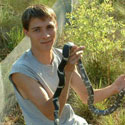Gabriel Miller, M.S. (Dec. 2008)
Email: gmill711@hotmail.com
 Gabriel Miller received a Master of Science degree in December
2008 from the Department of
Wildlife Ecology and Conservation at the University of Florida. His thesis research examined
the ecology of upland snake species of the Southeast, specifically the
Florida Pine Snake (Pituophis melanoleucus mugitus), a species
of special concern in Florida. Gabe’s research focused on determining
home ranges and microhabitat preferences and investigating the
interspecies relationships with the Southeastern Pocket Gopher (Geomys
pinetus). After graduate school, Gabe worked with the Florida Fish and
Wildlife Conservation Commission in the Big Bend
region at several Wildlife Management Areas (WMAs), where he had the
opportunity to conduct habitat restoration and land management for the
benefit of amphibians, reptiles, and other wildlife species. Gabe is
currently employed as a Biologist with the Minnesota Department of
Natural Resources.
Gabriel Miller received a Master of Science degree in December
2008 from the Department of
Wildlife Ecology and Conservation at the University of Florida. His thesis research examined
the ecology of upland snake species of the Southeast, specifically the
Florida Pine Snake (Pituophis melanoleucus mugitus), a species
of special concern in Florida. Gabe’s research focused on determining
home ranges and microhabitat preferences and investigating the
interspecies relationships with the Southeastern Pocket Gopher (Geomys
pinetus). After graduate school, Gabe worked with the Florida Fish and
Wildlife Conservation Commission in the Big Bend
region at several Wildlife Management Areas (WMAs), where he had the
opportunity to conduct habitat restoration and land management for the
benefit of amphibians, reptiles, and other wildlife species. Gabe is
currently employed as a Biologist with the Minnesota Department of
Natural Resources.
Publications
Thesis Abstract (Full-text link below abstract)
HOME RANGE SIZE, HABITAT ASSOCIATIONS AND REFUGE USE OF THE FLORIDA
PINE SNAKE, Pituophis melanoleucus mugitus, IN SOUTHWEST GEORGIA, U.S.A.
Knowledge of spatial ecology, habitat, and resource requirements is useful when considering the conservation of a species. Very little is known regarding these aspects of the ecology of the Florida pine snake (Pituophis melanoleucus mugitus). In this study, 12 Florida pine snakes were radio-tracked within a managed tract of longleaf pine (Pinus palustris) forest in southwest Georgia. Home range estimates were generated using three distinct methods, and variations in home range size between sexes and across seasons were examined. Habitat associations were examined at the landscape and within home range scales using Euclidean distance analyses. Microhabitat structure, refuge use and association were also examined.Overall, minimum convex polygon (MCP) home ranges of Florida pine snakes varied among individuals and were significantly smaller in fall/winter than spring and summer. Specifically, males had larger home ranges in spring than in summer or fall/winter, whereas females did not differ across seasons. Florida pine snakes were significantly associated with mixed pine hardwood forests at the landscape scale and all other habitats were used relative to their availability. I did not detect significant habitat associations for pine snakes at the home range scale and snakes were not associated with any particular microhabitats. Pine snakes predominately used pocket gopher burrows as fossorial refuges, though I did not detect an association with any refuges during their above-ground activities.
Florida pine snakes used large areas and selected for mixed pine-hardwood forest. Snakes were highly fossorial; therefore refuges, particularly southeastern pocket gopher burrows, are important resources for Florida pine snakes. It appeared that fragmentation by major roads and intensive agriculture may impede pine snake movements. Effective conservation of Florida pine snakes will require the protection, restoration and management of native habitats. Protecting native upland ecosystems and natural disturbance processes such as fire, will benefit pine snakes and, thereby, provide and maintain necessary resources.
- Miller, G. 2008. Home range size, habitat associations and refuge use of the Florida pine snake, Pituophis melanoleucus mugitus, in Southwest Georgia, U.S.A. M.S. Thesis, University of Florida, Gainesville.